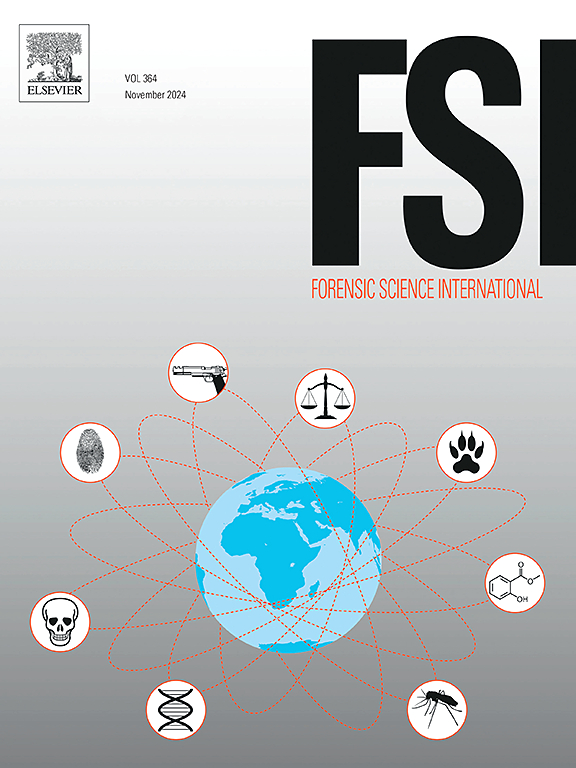Automated segmentation of the breech and firing pin faces of fired cartridge case images
IF 2.5
3区 医学
Q1 MEDICINE, LEGAL
引用次数: 0
Abstract
Firearm identification plays a crucial role in criminal justice globally. The capability to link firearms to specific crimes is invaluable for investigations and court cases. Each firearm leaves distinctive markings on bullets and cartridge cases, creating a “mechanical fingerprint” that can be used for the comparison of bullets and cartridge cases and underpins this area of forensic science. Cartridge cases fired from the same firearm exhibit similar markings on their bases. These traces can be used for investigation purposes as a means to potentially provide a link between more than one scene where cartridge cases have been recovered, or to provide a potential evidential link between a firearm and a cartridge case. These applications involve comparing the markings on the base of two or more cartridge cases, consisting of the headstamp, breech face and firing pin areas. The headstamp area usually contains information about the manufacturer and the calibre. Once this is considered, the remaining task is to compare the breech and firing pin areas of the two cartridges. Currently, some automated methods exist for this comparison, all of which involve the removal of the headstamp area to minimize bias. Some semi-automated methods for headstamp removal are available, and recently, an automated deep learning method that can be applied to 256 × 256 pixel resolution images has been introduced. In this article, we also propose a deep learning method addressing a more computationally demanding task of removing the head stamp area in higher-resolution images, 512 × 512 and 2592 × 1944 pixels, which will permit the automated extraction of finer features at a higher resolution. We also (a) introduce a post-processing method that improves the performance of our method, (b) provide the labelled data that we have produced so it can be used, together with the NIST database of cartridge case images, as a benchmark for future research, and (c) provide the estimated weights and models of the convolutional neural networks that can either be used directly or as initial values for further research. This article contributes to the emerging body of research on deep learning applications in forensic science.
自动分割后膛和发射销面发射的弹壳图像
枪支识别在全球刑事司法中发挥着至关重要的作用。将枪支与具体犯罪联系起来的能力对于调查和法庭案件是非常宝贵的。每把枪都在子弹和弹壳上留下了独特的标记,形成了一种“机械指纹”,可以用来比较子弹和弹壳,并巩固了这一法医科学领域。从同一支枪射出的弹壳在底座上有相似的标记。这些痕迹可以用于调查目的,作为一种手段,可能在多个弹壳被发现的现场之间提供联系,或者在枪支和弹壳之间提供潜在的证据联系。这些应用包括比较两个或更多的弹壳上的标记,包括头章,后膛面和射击销区域。头章区域通常包含有关制造商和口径的信息。一旦考虑到这一点,剩下的任务是比较两个弹药筒的后膛和射击销区域。目前,存在一些自动化的方法来进行这种比较,所有这些方法都涉及去除头戳区域以尽量减少偏差。一些半自动化的头印去除方法已经可用,最近,一种可以应用于256 × 256像素分辨率图像的自动化深度学习方法已经被引入。在本文中,我们还提出了一种深度学习方法,用于解决更高分辨率图像(512 × 512和2592 × 1944像素)中去除头部印章区域的计算要求更高的任务,这将允许在更高分辨率下自动提取更精细的特征。我们还(a)引入了一种后处理方法,提高了我们方法的性能,(b)提供了我们产生的标记数据,以便它可以与NIST的盒式图像数据库一起使用,作为未来研究的基准,(c)提供了卷积神经网络的估计权重和模型,可以直接使用,也可以作为进一步研究的初始值。本文对深度学习在法医学中的应用的新兴研究机构做出了贡献。
本文章由计算机程序翻译,如有差异,请以英文原文为准。
求助全文
约1分钟内获得全文
求助全文
来源期刊

Forensic science international
医学-医学:法
CiteScore
5.00
自引率
9.10%
发文量
285
审稿时长
49 days
期刊介绍:
Forensic Science International is the flagship journal in the prestigious Forensic Science International family, publishing the most innovative, cutting-edge, and influential contributions across the forensic sciences. Fields include: forensic pathology and histochemistry, chemistry, biochemistry and toxicology, biology, serology, odontology, psychiatry, anthropology, digital forensics, the physical sciences, firearms, and document examination, as well as investigations of value to public health in its broadest sense, and the important marginal area where science and medicine interact with the law.
The journal publishes:
Case Reports
Commentaries
Letters to the Editor
Original Research Papers (Regular Papers)
Rapid Communications
Review Articles
Technical Notes.
 求助内容:
求助内容: 应助结果提醒方式:
应助结果提醒方式:


